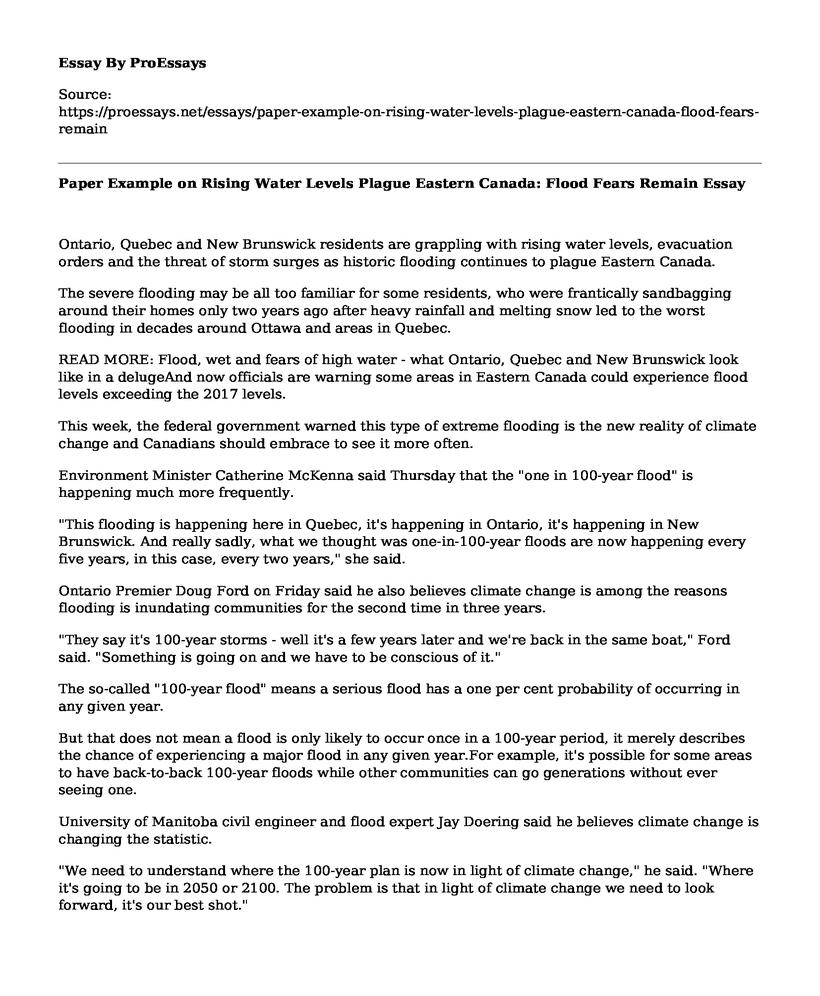Ontario, Quebec and New Brunswick residents are grappling with rising water levels, evacuation orders and the threat of storm surges as historic flooding continues to plague Eastern Canada.
The severe flooding may be all too familiar for some residents, who were frantically sandbagging around their homes only two years ago after heavy rainfall and melting snow led to the worst flooding in decades around Ottawa and areas in Quebec.
READ MORE: Flood, wet and fears of high water - what Ontario, Quebec and New Brunswick look like in a delugeAnd now officials are warning some areas in Eastern Canada could experience flood levels exceeding the 2017 levels.
This week, the federal government warned this type of extreme flooding is the new reality of climate change and Canadians should embrace to see it more often.
Environment Minister Catherine McKenna said Thursday that the "one in 100-year flood" is happening much more frequently.
"This flooding is happening here in Quebec, it's happening in Ontario, it's happening in New Brunswick. And really sadly, what we thought was one-in-100-year floods are now happening every five years, in this case, every two years," she said.
Ontario Premier Doug Ford on Friday said he also believes climate change is among the reasons flooding is inundating communities for the second time in three years.
"They say it's 100-year storms - well it's a few years later and we're back in the same boat," Ford said. "Something is going on and we have to be conscious of it."
The so-called "100-year flood" means a serious flood has a one per cent probability of occurring in any given year.
But that does not mean a flood is only likely to occur once in a 100-year period, it merely describes the chance of experiencing a major flood in any given year.For example, it's possible for some areas to have back-to-back 100-year floods while other communities can go generations without ever seeing one.
University of Manitoba civil engineer and flood expert Jay Doering said he believes climate change is changing the statistic.
"We need to understand where the 100-year plan is now in light of climate change," he said. "Where it's going to be in 2050 or 2100. The problem is that in light of climate change we need to look forward, it's our best shot."
Daniel Henstra, a specialist in flood management policies and assistant professor at the University of Waterloo's political science department, believes the "100-year flood" phrase is tricky and difficult to know if the statistic is increasing.
"The term '100-year flood' gives an idea that we will only experience a flood every 100 years, but it could happen two years in a row," he said
It's difficult to isolate whether flood hazards are changing as the provincial and federal governments are not great are keeping long-term records of flood data, he explained.
"There have been cutbacks and a lack of investments in monitoring systems that would help better understand whether severe flooding events are becoming more common," Henstra said.
"That's what makes it so maddening."
Henstra said although it may be difficult to determine whether the "100-year flood" number is increasing, one thing is certain, the cost of flooding is on the rise.
"It is not inaccurate to say costly floods are happening more often, that is true," Henstra said.
There are a number of factors at play, he said. More people are building homes in risky flood zones, properties are worth more and there is, of course, changing weather patterns.
A 2017 report by the Munk School of Global Affairs found that flooding is now more costly than fire or theft for property owners. Almost two million households in Canada are at "very high risk" of flooding. Federal disaster relief has almost doubled over the last few years and it's projected to rise to as much as $650 million annually.
On Friday, Public Safety Minister Ralph Goodale said climate change means annual flooding that damages homes is not going away and it is only going to get worse.
Flooding in Canada 'most obvious manifestation' of climate change: Goodale
"This is one of the most obvious manifestations of a changing climate," Goodale said.
"More unstable weather conditions where you can get precipitation that dumps years worth of moisture in a day or two. And then it all floods and causes enormous damage to private property as well as public infrastructure, as well as the economy," Goodale said, adding that it costs the federal government around one billion dollars a year to clean up after flooding and wildfiresCanadians should brace for more flooding in the future due to climate change, Henstra said.
"Scientists say the temperature and precipitation patterns we see today are consistent with changing climate ... and so they do expect we will see more flooding in future because of more extreme precipitation, which continues to impact river and urban flooding and also in coastal areas because of rising sea levels," he said.."
"It's about long-range planning, not just compensating people year after year," he said. "Governments should plan how to bring an end to flooding on property."
- With files from the Canadian Press
Cite this page
Paper Example on Rising Water Levels Plague Eastern Canada: Flood Fears Remain. (2023, May 23). Retrieved from https://proessays.net/essays/paper-example-on-rising-water-levels-plague-eastern-canada-flood-fears-remain
If you are the original author of this essay and no longer wish to have it published on the ProEssays website, please click below to request its removal:
- Pan Africanism Speech by Kwame Ture - Essay Example
- Dissertation Example: Preparedness and Ability of Emergency Room Physicians to Respond to CBRNE Incidents
- Essay Example on Trees: Our Lifeline to Climate Change Solutions
- Essay on Illegal Hunting & Trade of Endangered Species in Africa: Causes & Consequences
- Essay on U.S. and U.K. Political System: Advantages and Disadvantages
- Essay Example on Founding Fathers: The Legacy of the Declaration, Constitution, and Danbury Letter
- Free Education - Essay Example







